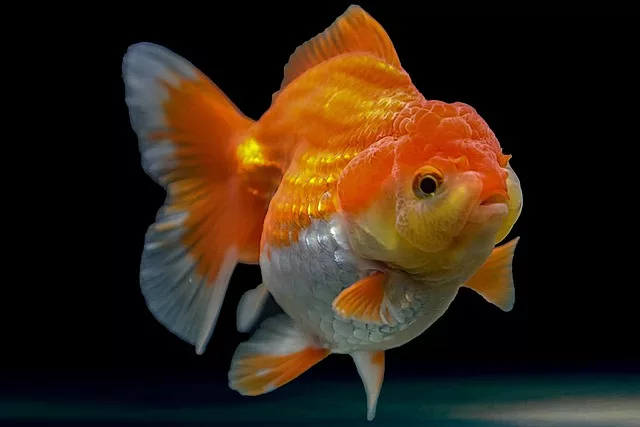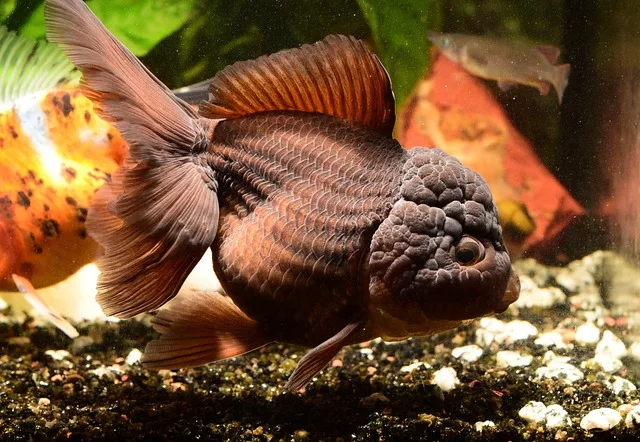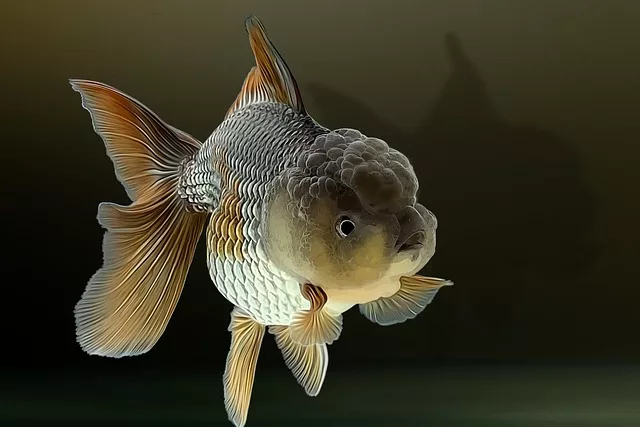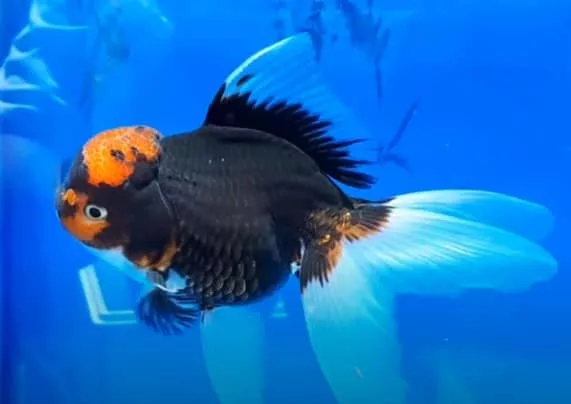Table of Contents
Oranda Goldfish Care Guide & Species Profile
The Oranda goldfish, a stunning freshwater fish from the Cyprinidae family, is a result of selective breeding closely related to the common goldfish. This captivating fish is easily recognized by its distinctive fleshy hood on its head. This feature, along with its vibrant variety of colors, makes it a prized choice for many aquarists. Adding to its charm, Oranda goldfish are peaceful companions, readily coexisting with other temperate fish of similar size.

Oranda Goldfish Facts & Over
| Scientific name | Carassius auratus auratus |
|---|---|
| Common names | Red cap goldfish, bullhead oranda goldfish |
| Distribution | Worldwide |
| Size | 8–9 inches |
| Life expectancy | 15 years |
| Color | Orange, red, red-and-white, red-and-black, black, blue, chocolate, bronze, white or silver, black-and-white, red-black-and-white, and calico |
| Diet | Omnivore |
| Temperament | Peaceful |
| Minimum tank size | 20 gallons |
| Temperature | 65–72°F (17–22°C) |
| pH | 5.0–8.0 |
| Hardness | 5–19 dGH |
| Care level | Moderate |
| Breeding | Egg-layer |

Origin
The Oranda Goldfish: A Fancy From Ancient Times
The Oranda goldfish (Carassius auratus auratus) is a stunning product of selective breeding, representing one of the oldest fancy goldfish varieties cultivated in Asia. Its exact origin remains a mystery, but like all goldfish, the Oranda traces its lineage back to wild carp, specifically the Prussian carp.
Today, Oranda goldfish grace aquariums and ponds around the world. However, due to their entirely captive existence, they’re not listed as a distinct species by the International Union for Conservation of Nature and Natural Resources (IUCN).
Key characteristics of the Oranda goldfish:
- Distinctive hood: The most striking feature of the Oranda is its prominent hood, also known as a wen or crown. This fleshy growth adorns the top of the head and can even cover the entire face except for the mouth.
- Metallic or matte scales: Orandas come in a dazzling array of colors and patterns, with metallic or matte scales adding to their visual appeal.
- Veiltail-like body: Similar to the veiltail goldfish, the Oranda boasts a large, elongated body with a deep profile.
- Quadruple tail: The tail fin is a true showstopper, featuring four distinct lobes that spread out elegantly when the Oranda glides through the water.
Keeping Oranda goldfish:
If you’re captivated by the Oranda’s beauty and considering adding one to your aquatic haven, remember that these fancy goldfish require specific care to thrive. Here are some essential points to keep in mind:
- Spacious tank: Orandas need ample swimming space, so a larger tank is crucial. Aim for at least 50 gallons for the first Oranda and 20 additional gallons for each subsequent fish.
- Clean water: Excellent water quality is paramount for Oranda health. Regular water changes and a robust filtration system are essential.
- Balanced diet: Provide a varied diet rich in high-quality goldfish pellets, flakes, and occasional treats like vegetables and brine shrimp.
With proper care and attention, Oranda goldfish can bring years of joy and wonder to your aquatic world. Their captivating appearance, coupled with their generally peaceful nature, makes them a cherished addition for many fishkeepers.

Adult Size & Lifespan
Oranda goldfish: Size and Lifespan
Oranda goldfish typically reach a length of 8 to 9 inches, but their size can vary greatly depending on genetics and tank conditions. Some exceptional individuals can even grow much larger, like the record-breaking 14-inch goldfish bred in Hong Kong!
These friendly fish live an average of 15 years, but can happily thrive for up to 20 years in a spacious and well-maintained tank.
Appearance & Behavior
Oranda goldfish stand out for their unique headgrowth, a fluffy cap of flesh perched atop their heads. Like other types of goldfish, these peaceful creatures make ideal tank mates for other calm fish.
Colors, Patterns, Fins, and Sex Difference
The Distinctive Oranda Goldfish
The oranda goldfish stands out from its relatives with its unique raspberry-shaped head covering, called a wen or crown. This cap can sit atop the head or fully cover the face, leaving only the mouth exposed.
Unlike other goldfish, the oranda’s cap only starts forming at three to four months old and takes an additional one to two years to reach its full glory. Its growth continues until the oranda reaches two to three years old.
Elegant Body and Dazzling Colors
With an egg-shaped body and a sizeable belly almost as wide as its length, the oranda showcases its beauty in shimmering metallic or matte scales. These scales come in a rainbow of colors, from red and black to calico, chocolate, red-and-white, blue, and even red-black-and-white.
Popular Color Variations:
While orange and yellow dominate, several stunning variations exist. Black orandas sport the same features but in an entirely black coat. Blue orandas captivate with their vibrant range, from light bluish-gray to deep sapphire. The coveted red cap oranda boasts a near-white body and a bright-red crown, often smaller and less intrusive than other orandas.
Symmetrical Fins and Spawning Season Traits:
Except for the dorsal fin, all the oranda’s fins are paired, creating a balanced appearance. The long, flowing caudal fin fans out when the fish rests.
During spawning season, male orandas develop bumps on their heads and pectoral fins called tubercles. Similarly, female bellies swell as they carry eggs.
Typical Behavior
Known for their tranquil nature, oranda goldfish make ideal additions to peaceful community aquariums, swimming alongside other temperate fish of comparable size. Despite their moderate swimming speed, these energetic goldfish constantly delight observers with their lively antics.
While not the fastest swimmers, they’re remarkably active, often playfully disrupting the aquatic plants. This particular species of goldfish showcases extensive mobility throughout the tank, spending time in both top and bottom areas. Unlike many other fish species, orandas rarely hide, preferring to stay out in the open most of the time.
Oranda Goldfish Care & Tank Requirements
Not the easiest goldfish around: Oranda goldfish are stunning, but they’re also one of the more delicate breeds. This makes them better suited for intermediate fish keepers than beginners. Outdoor ponds and cold temperatures are no bueno for these fancy fish, as their bodies are built for life in larger, well-kept aquariums with clean, oxygen-rich water and a soft, sandy bottom.
Foodie delights: Good news! Orandas are omnivores, so they’ll happily munch on fish flakes alongside frozen or fresh treats like brine shrimp, blood worms, and tubifex worms.
Habitat and Tank Requirements
Keeping Orandas Happy and Healthy:
Orandas are delicate goldfish that require a well-maintained tank to thrive. The right aquarium size and shape are key to their health and happiness. Choose an elongated tank to give them plenty of swimming space and prevent oxygen problems and stunted growth.
Since orandas are selectively bred, we can’t look to their wild ancestors for tank setup tips. However, their basic conditions should be similar to those of wild carp.
Clean water is vital. Perform weekly water changes of 25-35%. Orandas produce more waste than other freshwater fish, so a reliable filter and regular water changes are essential. Be aware that orandas love to dig, so sharp gravel or rough substrates can injure them. Stick with rounded gravel or fine sand instead. Smooth rocks and ornaments without sharp edges are also good choices for decorating their home.
When it comes to décor, plants are the best option for orandas. However, choose small, sturdy varieties that won’t limit their swimming space, as they need plenty of room to move. Artificial silk plants can be a good alternative, as orandas tend to nibble on leaves and dig in the substrate, which can uproot live plants.
By following these tips, you can ensure your oranda goldfish lives a happy and healthy life in its beautiful tank.
Tank Conditions
Oranda Goldfish Care Guide
Tank Size
- A suitable tank size for a single oranda goldfish is a minimum of 20 gallons, although a 30-gallon tank is preferred.
- To accommodate additional oranda goldfish, it is advisable to increase the tank size by 10 gallons for each additional fish.
- Adult orandas typically grow to around 9 inches in length and require a spacious tank to support their growth. Keeping an oranda goldfish in a small tank can result in stunted growth. Limited swimming space can cause stress and illness in these fish.
Temperature
- Oranda goldfish are particularly sensitive to low water temperatures and cannot tolerate temperatures below 60°F.
- To ensure their well-being, it is recommended to invest in a reliable water thermometer and regularly monitor the water temperature.
- The ideal temperature range for oranda goldfish is between 65–72°F.
Water Quality
- In addition to a quality filtration system, it is essential to have a robust aeration system in place to maintain optimal oxygen levels in the water.
- Despite their striking size and flowing fins, oranda goldfish are not strong swimmers and do not handle strong water currents well. To mitigate this, you can reduce the water flow from the aquarium filter by strategically placing rocks, caves, and plants, or by restricting the flow at the filter’s intake.
Additional Tips
- Feed your oranda goldfish a healthy diet of high-quality pellets and flakes. Avoid overfeeding, as this can pollute the water.
- Perform regular water changes to remove waste products and maintain good water quality.
- Provide your oranda goldfish with hiding places, such as caves and plants, to feel secure.
| Water type | Normal freshwater |
|---|---|
| Tank size | 20-gallons minimum, 30-gallons preferred |
| Water temperature | 65–72°F (17–22°C) |
| Substrate | Sand, rounded, medium-sized gravel |
| Tank setup | Plants, smooth rocks, decorations without sharp points or edges |
| Acidity | 5.0–8.0 pH |
| Water hardness | 5–19 dGH |
| Filter | Yes, oranda goldfish create a lot of waste and need a powerful filtration system |
| Pump | Yes, these fish prefer living in highly-oxygenated water |
Give your Oranda goldfish the space they deserve to swim and explore! A big aquarium with a strong filter and air pump keeps the water sparkling clean and full of oxygen, just like they love it. Happy and healthy goldfishes guaranteed!
Disease
Oranda Goldfish and Common Diseases:
Just like other freshwater fish, Oranda goldfish can catch common fish diseases. But don’t worry, these beauties are tough! With quick treatment, most Orandas will make a full recovery.
Here are some diseases to watch out for:
Ich: This common parasite makes tiny white spots appear on your Oranda’s body, gills, and fins. It’s super contagious, so quarantine the affected fish immediately. Treatments include non-iodized sea salt or special antiparasitic medication.
External Parasites: Flatworms and fish lice (think creepy underwater mites) can come in with new food or plants. Flatworms hang onto your Oranda with little hooks, while fish lice latch on like tiny pancakes. Non-iodized sea salt can help naturally banish fish lice, or you can use a chemical like diflubenzuron for tougher jobs.
Swim Bladder Disease: This one’s more common in round-bodied fancy goldfish like Orandas. You’ll know it if your Oranda struggles to stay upright. Constipation is often the culprit. Try feeding frozen or defrosted peas, or just skip feeding for a day to help things get moving again.
Overgrown Head Cap: This is exclusive to Orandas. If their head cap starts growing too much, it can block their vision and make it hard to eat. In extreme cases, a vet might need to surgically trim it back.
Remember, early detection and treatment are key to keeping your Oranda healthy and happy. If you notice any suspicious changes, act fast and consult a fish vet if needed.
Tank Mates
Oranda goldfish: Friendly and social, these charming fish flourish in community tanks. But their leisurely pace puts them at a disadvantage when sharing food with speedy goldfish like shubunkins, common goldfish, and comets. It’s best to avoid housing Orandas with these faster tankmates.
Their ideal companions? Orandas shine when surrounded by their own kind or other fancy goldfish varieties. Here are some fantastic tank mates:
- Peppered cory catfish: These helpful bottom-dwellers clean up leftover food and keep the tank bottom pristine.
- Sailfin pleco: This algae-eating giant will gladly take care of tank greenery while leaving your Orandas undisturbed.
- Pearlscale goldfish: Their shimmering scales complement Orandas beautifully, and their similar pace ensures peaceful coexistence.
- Black moors: These elegant black goldfish with their telescope eyes add a touch of mystery to the tank and get along well with Orandas.
- Ryukin goldfish: With their flowing tails and plump bodies, Ryukins bring a touch of whimsy to the tank and share Orandas’ laid-back demeanor.
A gentle reminder: While snails may seem like good tank mates, Orandas might see them as a tasty snack. It’s best to choose fish friends for your Oranda’s happiness and safety.
Diet and Feeding
Orandas are omnivores with a diverse diet, readily consuming various types of fresh, frozen, and flake foods. They have a big appetite and will eat anything offered, so it’s important to provide daily high-quality flake food for optimal health. As an occasional treat, choose freeze-dried options like brine shrimp, tubifex worms, blood worms, or Daphnia. Live foods carry a risk of parasites and bacteria, so freeze-dried is safer.
Overeating is common, so watch for signs like swimming upside down or constipation (caused by a swim bladder issue). If your oranda flips over, stop feeding for 24 hours, then resume with smaller portions. Adults need feeding once a day, while young fish need two meals daily. Large wens can make it harder for them to see and eat, so allow them extra time at feeding time.
Breeding
Breeding Oranda Goldfish:
Oranda goldfish are relatively easy to breed in the right environment. They can do well in small groups of up to five, but larger groups generally have better success. Goldfish naturally spawn in late spring or early summer, so creating similar conditions is key for breeders.
Preparing for Spawning:
- Separate the sexes: Keep male and female orandas apart for a few weeks before introducing them to the breeding tank at the same time.
- Set up the tank: Include solid surfaces, bushy plants, or spawning mops (fibrous objects) for the eggs to stick to.
- Adjust the temperature: Gradually lower the water temperature to 60°F, then slowly increase it by 3°F each day until spawning happens. Orandas usually spawn between 68°F and 74°F.
- Boost their diet: Feed the fish small amounts of high-protein food (live brine shrimp or worms) three times a day to encourage spawning.
The Spawning Process:
- Courtship: Before spawning, the male will chase the female gently.
- The dance: During spawning, both fish will swim side-to-side in a “gyration” motion. The male guides the female to plants where she lays eggs, and he fertilizes them.
- Egg laying: Female orandas can lay a lot of eggs (over 10,000!) in just 2-3 hours.
- After spawning: After they finish, remove both parents from the tank immediately to prevent them from eating the eggs.
Raising the Fry:
- Hatching time: Fertilized eggs typically hatch in 4-7 days, depending on the water temperature.
- Feeding the fry: Once hatched, feed the tiny fry with infusoria (microscopic organisms) or special fry food until they’re big enough for brine shrimp or fish flakes.
Oranda Goldfish: A Dive into Elegance and Grace ????✨
Introduction to Oranda Goldfish
Welcome to the enchanting world of Oranda Goldfish, where elegance meets aquatic grace! ???????? In this deep dive into the realm of ornamental fish, we’ll unravel the unique qualities that make Oranda Goldfish stand out among their aquatic companions.
Physical Characteristics ????????
At the heart of the Oranda’s allure lies its unique physical features. The most captivating among them is the prominent head growth, affectionately known as the “wen.” This fleshy hood gives the Oranda an almost regal appearance, setting it apart in the underwater tapestry. Additionally, the breed showcases a mesmerizing array of colors and patterns, turning each individual into a living work of art.
Habitat and Tank Requirements ????????
Creating a haven for your Oranda Goldfish is more than just providing water and a tank. These fish thrive in specific water conditions, emphasizing the need for pristine water quality. An adequately sized tank with proper filtration is essential to mimic their natural habitat. Dive into the intricacies of maintaining the perfect aquatic home to ensure a happy and healthy companion.
Feeding Habits ????️????
Ensuring the longevity and vibrancy of your Oranda Goldfish starts with a balanced diet. Dive into the specifics of their dietary preferences and establish a consistent feeding schedule. Explore the world of high-quality fish food to meet their nutritional needs, preventing health issues and enhancing their radiant colors.
Oranda Goldfish Breeding ????????????????
For the enthusiasts looking to expand their aquatic family, understanding the art of Oranda Goldfish breeding is vital. From recognizing subtle mating behaviors to caring for the delicate fry, successful breeding requires careful consideration and an attentive eye. Embark on the journey of nurturing the next generation of these aquatic wonders.
Common Health Issues ????????
Despite their hardy nature, Oranda Goldfish are not immune to health issues. Equip yourself with knowledge on recognizing early signs of illness, from swim bladder issues to fungal infections. Implement preventive measures to maintain a thriving and resilient aquatic community.
Interaction and Compatibility ????????
Oranda Goldfish are not just stunning to behold; they also exhibit fascinating social behaviors. Delve into the nuances of their compatibility with other fish species, unraveling the secrets to creating a harmonious and lively tank environment.
Oranda Goldfish in Art and Culture ????????
Beyond the glass confines of aquariums, Oranda Goldfish have transcended into the realms of art and culture. Discover their symbolic significance across various cultures and how these fish have become a muse for artists worldwide. Uncover the intersection of aquatic beauty and human creativity.
Tips for Enthusiasts ????????????
For those who find joy in the care of these majestic creatures, the journey doesn’t end with the basics. Explore advanced tips to enhance the aesthetic appeal of your tank, from creative aquascaping to selecting suitable tankmates. Build a thriving community of fellow enthusiasts, fostering knowledge sharing and a deeper appreciation for this captivating hobby.
Sustainability and Conservation ????????
As responsible pet owners, it’s paramount to consider the environmental impact of keeping Oranda Goldfish. Dive into the world of sustainable practices, ensuring the longevity of both the hobby and the well-being of these remarkable aquatic companions.
Conclusion ????????
In the vast ocean of ornamental fishkeeping, the Oranda Goldfish stands as a beacon of elegance and grace. Its distinctive features, coupled with a rich history, make it a favorite among enthusiasts worldwide. Whether you’re a seasoned aquarist or a beginner, the journey of caring for Oranda Goldfish promises a rewarding and captivating experience.
Frequently Asked Questions (FAQs) ❓????
Can Oranda Goldfish live with other types of goldfish?
Understanding compatibility is crucial; some breeds may coexist peacefully, while others may not.
How often should I feed my Oranda Goldfish?
Maintain a consistent feeding schedule, typically 1-2 times a day, to support their nutritional needs.
What are common health issues, and how can I address them?
Keep an eye out for signs of swim bladder issues or fungal infections, and consult a vet if needed.
Is breeding Oranda Goldfish suitable for beginners?
While it requires dedication, breeding Oranda Goldfish is achievable for enthusiasts with some experience.
Are there specific cultural beliefs associated with Oranda Goldfish?
In various cultures, Oranda Goldfish symbolize prosperity and good fortune, adding cultural depth to their allure.
You may also like
- https://www.giobelkoicenter.com/how-to-groom-goldfish/
- https://www.giobelkoicenter.com/koi-fish-meaning/
- https://www.giobelkoicenter.com/most-expensive-koi-fish/
- https://www.giobelkoicenter.com/matsuba-koi/
- https://www.giobelkoicenter.com/koi-egg-bound/
- https://www.giobelkoicenter.com/metronidazole-for-fish/
